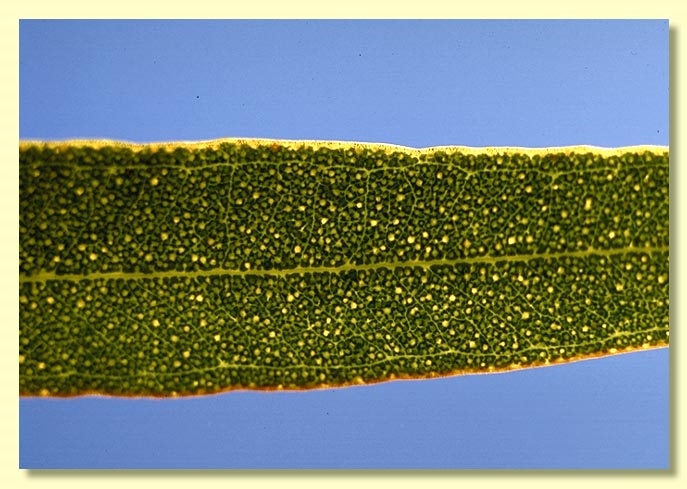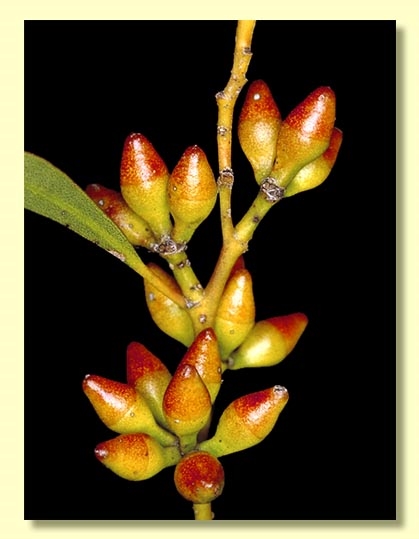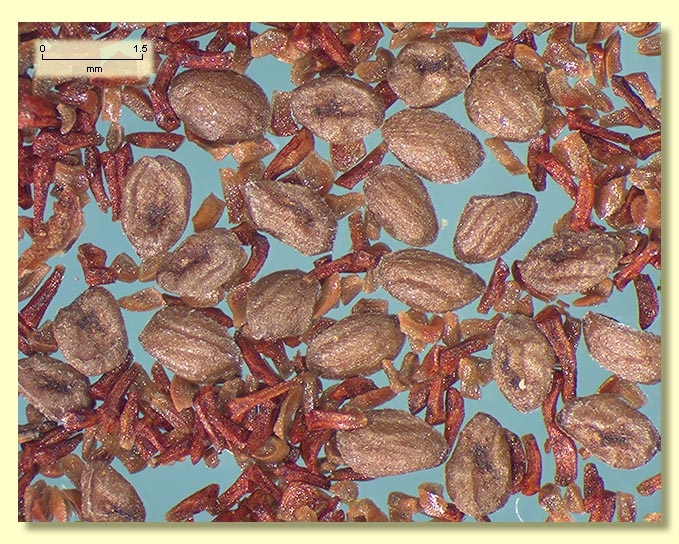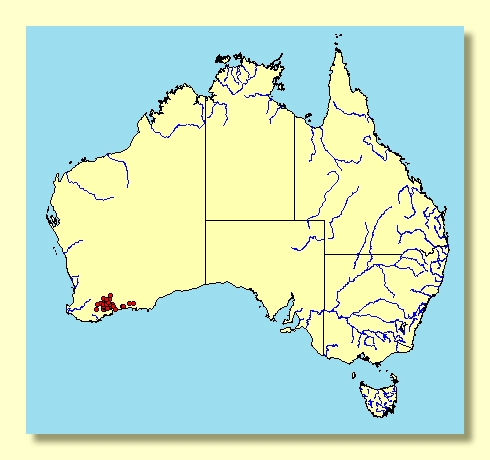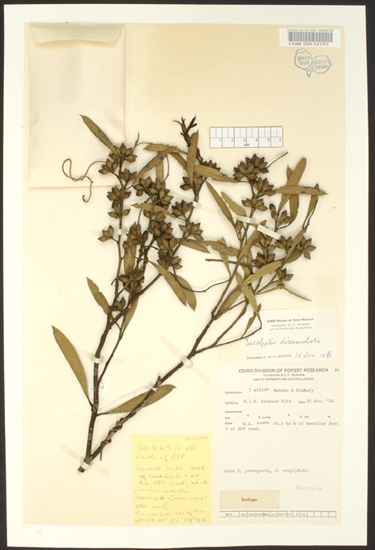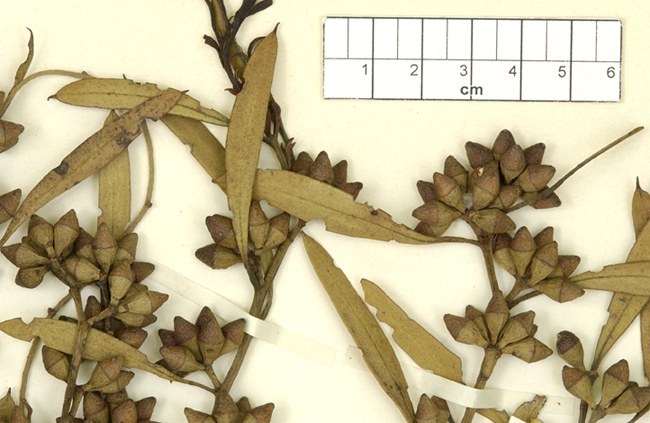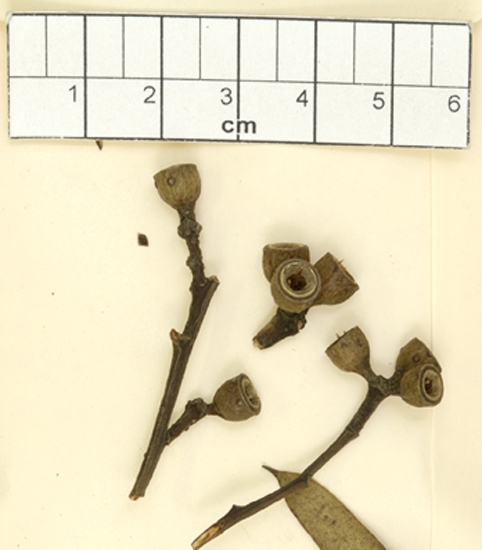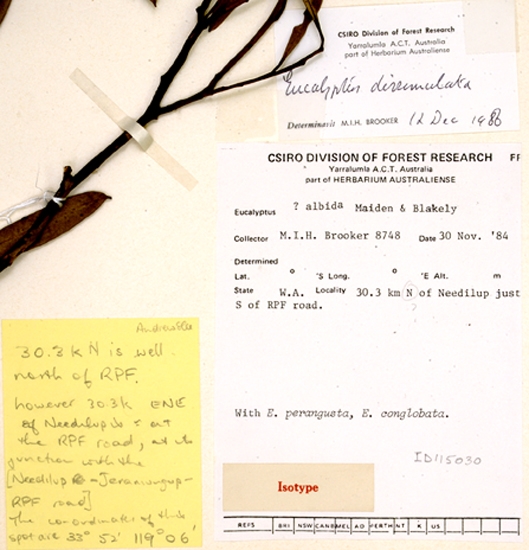Euclid - Online edition
Eucalyptus dissimulata
Eucalyptus | Symphyomyrtus | Bisectae | Destitutae | Porantherae | Longiores
Bark wholly smooth, light grey to greenish grey over brown, shedding in strips.
Branchlets lacking oil glands in the pith.
Juvenile growth (coppice or field seedlings to 50 cm): stems rounded in cross-section, warty or smooth; juvenile leaves sessile and opposite to sub-opposite, elliptical, 2.5–4.5 cm long, 1–1.5 cm wide, grey-green, dull.
Adult leaves alternate, petioles 0.5–1.8 cm long; blade narrowly elliptical to narrowly lanceolate or ± narrowly oblanceolate, 4.5–9.5 cm long, 0.5–1.7 cm wide, base tapering to petiole, margin entire, apex finely pointed, glossy, green, usually side-veins greater than 45° to midrib but sometimes with side-veins acute, reticulation dense, intramarginal vein present, oil glands intersectional.
Inflorescence axillary unbranched, peduncles rounded or ± flattened, 0.5–2 cm long, buds 7, 9 or 11 per umbel, pedicels 0.1–0.5 cm long. Mature buds ovoid to diamond-shaped (0.7–1.2 cm long, 0.4–0.5 cm wide), scar present, operculum bluntly to acutely conical (0.3–0.5 cm long), stamens inflexed, anthers cuneate-cuboid, adnate to filament apex (rigidly basifixed), dehiscing by sub-terminal pores, a few of the innermost stamens imperfectly formed, style long and straight, stigma tapered, locules 3(4), the placentae each with 4 vertical rows of ovules. Flowers creamy white.
Fruit pedicellate (pedicels 0.1–0.3 cm long), shortly cylindrical to stoutly barrel-shaped, 0.5–0.7 cm long, 0.5–0.8 cm wide, disc raised slightly at outer edge then descending or flattish, valves 3(4), more or less enclosed.
Seeds brown to brown-grey, 1–2.2 mm long, flattened-ovoid, dorsal surface usually longitudinally furrowed, surface smooth, hilum ventral.
Cultivated seedlings (measured at node 10): cotyledons Y-shaped (bisected); stems rounded in cross-section; leaves sessile and opposite for 11 to 18 nodes, rarely for as few as 8 nodes, then leaves becoming alternate, elliptic-oblong to ovate, 1.3–4 cm long, 0.5–2 cm wide, base rounded to tapering, margins sometimes minutely denticulate due to warts, slightly discolorous, dark green above, dull.
Flowering has been recorded in January and December.
A small mallee endemic to Western Australia, of restricted occurrence in sub-coastal areas of the southern wheatbelt from Ongerup in the west, north and east to Lake Magenta, Lake Grace and Hyden and east to Salmon Gums and Grasspatch. The bark is smooth and the adult leaves glossy green.
Eucalyptus dissimulata belongs in Eucalyptus subgenus Symphyomyrtus section Bisectae subsection Destitutae because the buds have two opercula, cotyledons are Y-shaped and branchlets lack oil glands in the pith. Within this subsection E. dissimulata is one of a group of about 16 species, series Porantherae, that are further characterised by having anthers completely adnate to the staminal filaments, strongly inflexed stamens, densely reticulate leaves with intersectional oil glands and by the fruit with a distinct thick rim that includes a whitish descending disc. The small, glossy leaves of species in series Porantherae may result in confusion with species in series Heterostemones; however, the fruit alone usually distinguish the series. The fruit of series Heterostemones are thin-rimmed.
The operculum of E. dissimulata is bright red near flowering. The rim of the fruit is thick and the fruit are sometimes very slightly angled. It has long been confused with E. albida, which overlaps in distribution but has very glaucous, almost white orbicular juvenile leaves, very glossy adult leaves and always has a twisted style that is especially noticeable in immature fruits. The juvenile leaves of E. dissimulata are elliptical, never stem-clasping, and are greenish; the style is always straight. Another related species, E. uncinata, also occurs within the range of E. dissimulata and has opposite juvenile leaf pairs connate around the stem and sessile or almost sessile, smaller buds and fruit.



